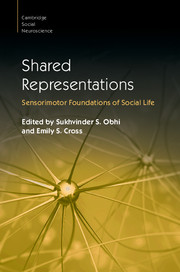Book contents
- Shared Representations
- Cambridge Social Neuroscience
- Shared Representations
- Copyright page
- Contents
- Figures
- Tables
- Boxes
- Contributors
- Preface
- Part I Foundations
- Part II Imitation and Mimicry
- Part III Thinking, Perceiving and Acting with Others
- 10 Levels of Complexity and the Duality of Gaze
- 11 Acting Together
- 12 Joint Perception
- 13 Social Antecedents and Consequences of Behavioral Synchrony
- 14 Musical Ensemble Performance
- Part IV Understanding Others
- Part V Learning and Development
- Part VI Shared Representations in Applied Contexts
- Index
- Plate Section (PDF Only)
- References
11 - Acting Together
Representations and Coordination Processes
from Part III - Thinking, Perceiving and Acting with Others
Published online by Cambridge University Press: 27 October 2016
- Shared Representations
- Cambridge Social Neuroscience
- Shared Representations
- Copyright page
- Contents
- Figures
- Tables
- Boxes
- Contributors
- Preface
- Part I Foundations
- Part II Imitation and Mimicry
- Part III Thinking, Perceiving and Acting with Others
- 10 Levels of Complexity and the Duality of Gaze
- 11 Acting Together
- 12 Joint Perception
- 13 Social Antecedents and Consequences of Behavioral Synchrony
- 14 Musical Ensemble Performance
- Part IV Understanding Others
- Part V Learning and Development
- Part VI Shared Representations in Applied Contexts
- Index
- Plate Section (PDF Only)
- References
Summary
Human life involves and requires joint action. Coordinating our actions with others not only gives rise to cultural products that individuals could not achieve alone, such as the Egyptian pyramids or the performance of a symphony. Rather, everyday life also has us engage in many joint actions, from folding a sheet together to having a conversation. How do people manage to act together in a coordinated way? In this chapter, we consider this question in terms of the cognitive mechanisms underlying joint action, focusing on real-time interactions in dyads or small groups. To illustrate what we are aiming to explore, think of two people who are loading shopping bags into the trunk of a car. At times, they each take a rather light bag from the shopping cart, move towards the trunk and then coordinate who is setting their bag down first, and where. At other moments, they carry heavy bags together, making sure to lift and set these down at the same time. As this shows, performing a joint action often requires adapting one’s own actions to what another person is doing. In this chapter, we first introduce some key concepts that have been highlighted in previous accounts of joint action, briefly addressing shared intentions, commitment and representations of joint goals. The main part focuses on coordination mechanisms – cognitive processes and mental representations that make performing joint actions of the kind described above possible. Specifically, we will review findings from experimental studies that shed light on general coordination strategies, representations of joint abilities and tasks, mechanisms of predicting own and others’ actions, and non-verbal communication through action. We will conclude by discussing ways in which different coordination mechanisms might be combined to allow co-actors to take on complementary roles.
- Type
- Chapter
- Information
- Shared RepresentationsSensorimotor Foundations of Social Life, pp. 216 - 235Publisher: Cambridge University PressPrint publication year: 2016
References
- 3
- Cited by



